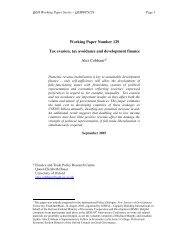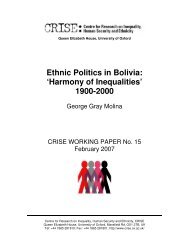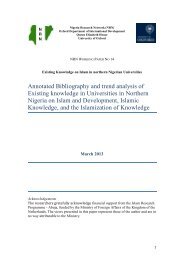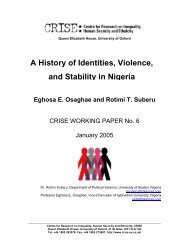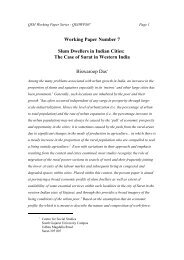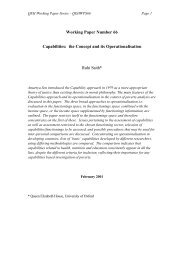Acute Multidimensional Poverty: A New Index for Developing ... - OPHI
Acute Multidimensional Poverty: A New Index for Developing ... - OPHI
Acute Multidimensional Poverty: A New Index for Developing ... - OPHI
You also want an ePaper? Increase the reach of your titles
YUMPU automatically turns print PDFs into web optimized ePapers that Google loves.
<strong>Acute</strong> <strong>Multidimensional</strong> <strong>Poverty</strong>: A <strong>New</strong> <strong>Index</strong> <strong>for</strong> <strong>Developing</strong> CountriesAlkire & Santoshand, the poverty estimates of Sao Tome and Principe, Gabon, Comoros, Slovenia, Syria, andSlovakia should be interpreted as upper bound estimates – meaning that multidimensional poverty isless than or equal to their MPI values. For the United Arab Emirates, Ecuador, Jordan, Chad, andColombia, despite the fact that they also had some significant sample reduction, we did not findevidence of under or over-estimationThe following sections highlight the salient results from our estimation and analysis. Please note thatthere is still ongoing work and analysis which will be incorporated into subsequent versions of thispaper.4.1 Who is poor? Global OverviewBelow we present a number of the interesting and thought-provoking MPI results. Some resultsexplore its comparative advantage in relation to income poverty; some illustrate the insights thatarise from the novel aspect of ‘intensity’; some simply describe its distribution across countries. Wealso per<strong>for</strong>m some basic robustness tests and more detailed country analyses such asdecompositions by dimension, region, and ethnicity; trends across time; and individual comparisonsbetween income- and MPI-poor people.4.1.1 The MPI headcounts fall between $1.25 and $2.00/day headcounts. The present resultscover 104 countries, which are home to 5,230 million or 5.2 billion people. Of these, 1,659 million(close to 1.7 billion) are poor according to the MPI. 50 For example, they could live in householdsthat have a member who is undernourished and no member has five years of education. Or theymight live in a household that has experienced a child death and is deprived in at least three livingstandard indicators (sanitation, water, cooking fuel, electricity, floor, and assets). Or they could livein a household that is deprived in three living standard indicators and in which there are school-agedchildren not attending school. According to the MPI, 32 percent of the total population in these 104countries is poor. This figure lies between the total number of people living on less than $ 1.25/day,which is 1,3789 million people (26 percent), and the total number of people living with less than$2/day, which is 2,525 million people (48 percent). 514.1.2 The MPI is measuring services and outcomes directly, so differs from income poverty.Although the global headcount is between $1.25/day and $2.00/day headcounts, the MPI is not a$1.50/day poverty line. Figure 5 presents our estimates <strong>for</strong> the 93 countries <strong>for</strong> which we haveincome poverty in<strong>for</strong>mation. The figure shows that acute multidimensional poverty complementsincome poverty. The zig-zag black line presents the income poverty headcount <strong>for</strong> each countrywhile the bar shows the multidimensional poverty headcount. The MPI headcount of poor personsis higher than the $2/day headcount in 24 countries and lower than $1.25/day headcount in 36others. There are several reasons <strong>for</strong> the observed divergence. In some cases, income data are weak50 Population figures correspond to 2007. This assumes that the poverty rates in the year of the most recent survey(which goes back as far as 2000) are an adequate reflection of poverty today. As none of these surveys post-date themore recent economic crisis, these may well be under-estimates. Note that if 2010 population figures are used, the totalnumber of MPI poor people is 1.75 billion.51 Note that the figures <strong>for</strong> the income poverty estimates exclude the following 14 countries <strong>for</strong> which this in<strong>for</strong>mationis not available: Czech Republic, Guyana, Namibia, Slovakia, Suriname, Trinidad and Tobago, the United Arab Emirates,the Occupied Palestinian Territories, Syria, Belize, Iraq, Myanmar, Zimbabwe, and Somalia. The total number ofmultidimensionally poor excluding these countries is 1,633 million, which still lies in-between the two income povertyestimates. If 2010 population figures are used, the total number of $ 1.25/day poor is about 1.44 billion, whereas thetotal number of $2/day is about 2.6 billion.www.ophi.org.uk July 2010 30



